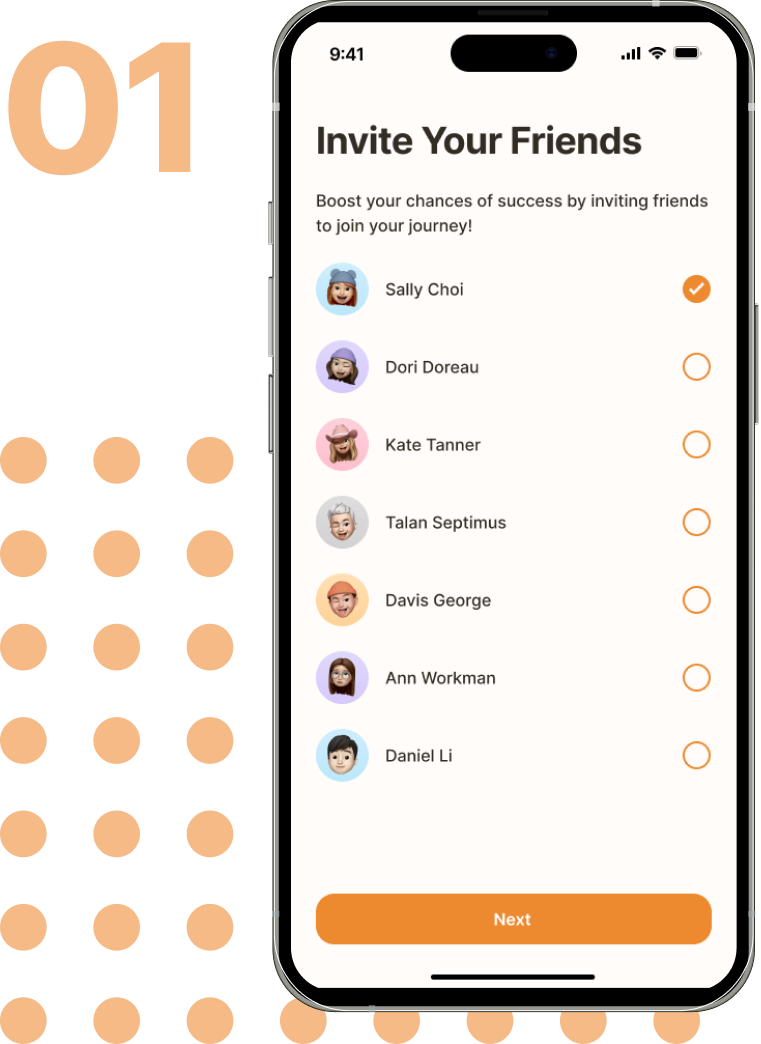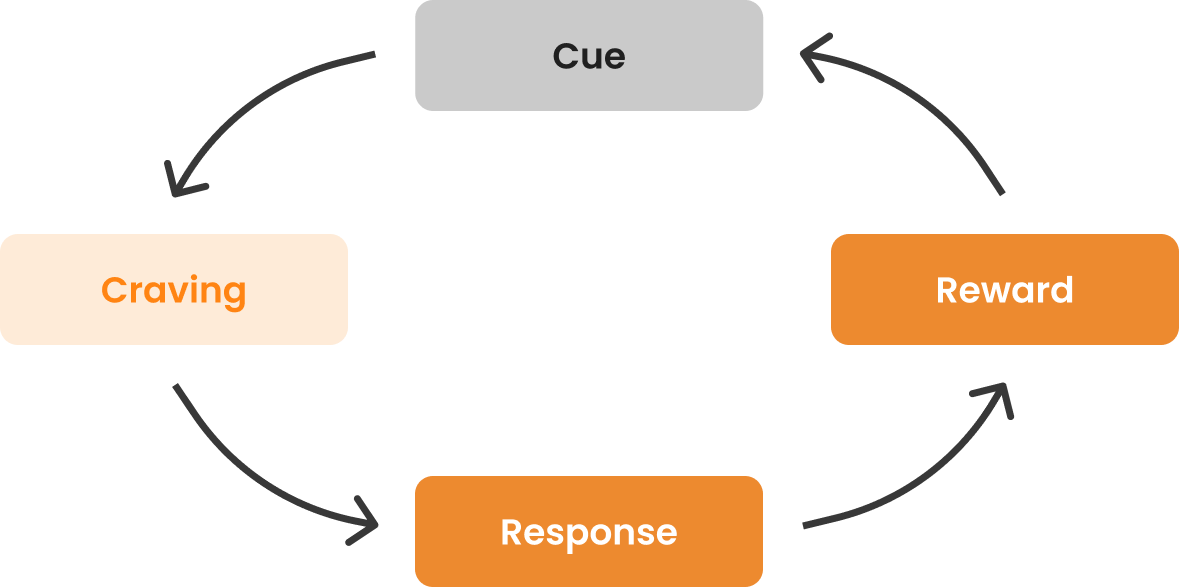Voilà
DESIGNING FOR A MOTIVATION-FOCUSED GOAL APP THROUGH ACCOUNTABILITY.
Engage
Share
Encourage
Problem
It’s a constant challenge to stay committed to our personal goals.
We often set goals and resolutions - whether it's losing weight, fixing our sleep schedules, or pursuing new hobbies with a sense of hope and enthusiasm. However, the reality is that over 90% of these goals are abandoned within a few weeks. This sparked a question -
How might we assist people in achieving and sustaining their goals?
Solution
Accountability-driven approach to inspire and sustain motivation among friends.
Principle, After Effects
Motivation meets accountability
Have an accountability partner increases success rates by 95% .
Sharing goals and progress fosters responsibility to oneself and others.
Supportive companions offer encouragement and friendly competition.
Keeping up with your goals
People who make a specific plan for when and where they will perform a new habit are more likely to follow through.
Measuring goals not only displays your progress but also acts as a motivating boost when you see the data.
Visualize progress with streaks
Seeing your streak grow day by day provides a visual representation of your commitment and progress.
An established streak eventually becomes a hard-to-break part of your routine.
Support for uninspiring days
Persistence, not perfection, is the key to reaching goals.
Allowing users to have occasional cheat days promotes a healthier mindset by encouraging moderation rather than strict perfectionism.
To skip over the detailed research, defining, and ideating parts of this case study and get straight to the overview of the final outcome, click on the button below!
Desk Research
Initial Findings
In order to better understand the topic of goals and motivation, I dove into white-paper research by seeking out statistics and relevant studies. Research from Ohio State University on resolutions found:
38%
of adults will make a New Year’s resolution.
92%
will not follow through on their resolution.
23%
give up by the end of the first week.
Understanding Behavioural Science
In my exploration of literature research, I came across James Clear's framework from his book "Atomic Habits," which delves into the science of individual habit formation.
His breakdown divides the process into four essential steps: cue, craving, response, and reward. Without the first three steps, a behavior will not occur. Without all four, a behavior will not be repeated.
The framework is called the Four Laws of Behavior Change, and it provides a simple set of rules for creating good habits. Breaking it down into these fundamental parts can help us understand what a habit is, how it works, and how to improve it.
Competitive Analysis
Analyzing the competitive landscape unveiled a market flooded with apps offering identical features.
I wanted to see if there were any standout features among the top reviewed applications in the field. Upon examination, I noticed that they all prioritize goal tracking features - which align with the first law of behaviour change: “Make it obvious.”
Structured
Me+ Daily Planner
Habitica
Fabulous
Despite the abundance of these apps, why do people still have trouble sticking to their goals?
Qualitative Research
I conducted further research on 6 individuals through semi-structured interviews to gain insights on why people fail to keep their goals, and if there were any approaches taken to overcome those challenges. These individuals all differed in age and occupation, providing a range of experiences and perspectives. A few sample questions are listed below:
Have you ever made resolutions or a goal? If so, what were they?Have you tried goal-tracking apps before? How did that go?Can you describe any methods or strategies you've used to hold yourself accountable for your goals?What hindered your progress? Did you manage to overcome them? If so, how?What motivates you to continue engaging in daily activities or hobbies that you enjoy? Are there rewards or other factors that play a role?
Throughout the interviews, the major theme I discovered was the lack of motivation. Lapses in motivation left them feeling uninspired and lacking the drive to continue their goals.
“I tend to lose motivation when I'm physically and emotionally drained after a demanding day at work.”
"I skipped my goal a few days, and eventually stopped altogether. Each missed day made it harder to pick up where I left off, and my motivation dwindled."
"I struggled to stay motivated as time went on. It was like hitting a wall."
Pain Points
Low motivation makes it difficult to even maintain goals, much less actually achieving them.
While goal tracking helps initially, its effectiveness diminishes as motivation wanes. The most impactful solution must be capable of maintaining long-term motivation.
Other key insights revealed...
Reminders are essential ⏰
Most people need to set a reminder for their goal to ensure it becomes a consistent part of their routine, helping them stay focused and committed.
People are socially motivated 👯
Having someone hold you accountable encourages you to stick to your plan, offering support during challenges and lifting you up during setbacks.
Pacing for success 🐢
Achieving the goal at one's own pace leads to a greater likelihood of long-term success.
User Persona
Summarizing key insights into goal-oriented personas.
User Storyboarding
User-Centric Perspective
After identifying the key pain points, I put myself in the user's shoes by creating scenarios that feature my personas. By depicting these ideas, I could better focus on aspects of the research problem that needed solving in the final design.
Affinity Mapping
How might we incentivize people to continue their goals when they are unmotivated?
Based on the extensive research, I gained valuable insights into the needs of people striving to achieve their goals. I used affinity mapping to better understand user preferences and refine the app's features, ensuring it's user-friendly and effective in supporting users on their goal achievement journey.
Working towards a solution
“It can be easy to quit on yourself if nobody knows you're trying to achieve a goal. When other people are watching, it's extra motivation to stick to it.”
I wanted to create an experience that allowed users to engage, share, and encourage each other to become active participants and foster a sense of community. This would be achieved through these 3 goals:
Accountability Partner
An accountability partner challenges you to adhere to your plan, providing support during difficulties and lifting you up in times of setback.
Sharing Success
Enabling users to share their progress creates a sense of achievement while also inspiring their peers.
Make it Fun
By integrating gamified elements such as streaks, users are incentivized to stay engaged and committed to their goals.
System Architecture
Minimizing the steps a user will take.
Outlining the steps a user will take to complete a goal from start to finish helps me figure out how I can minimize the number of steps needed. This also becomes a precursor to the development of wireframes.
Wireframes
With these steps in mind, I started designing low-fidelity wireframes to represent an initial overview of the app layout and functions.
Version 1
Version 2
Version 3
Finishing details
Refining the design based on feedback.
Final Product
Onboarding
Setting up a goal
Completing a goal
Accountability
Streaks and Achievements
Snoozing a goal
Project Takeaways
As this was my first case study, it was an invaluable learning opportunity. Based on this experience, I plan to implement several changes in future projects:
1. Value of User Interviews
Although the thorough research on behaviors was insightful, the user interviews proved to be far more valuable in terms of generating insights and innovative ideas.
2. Importance of a Strong Foundation
Allocating more time at the beginning of the project is crucial. Establishing a solid foundation early on helps streamline the process and reduces the need for constant polishing later.
3. Iterative Testing and Feedback
Even though this was an individual project, incorporating iterative testing and seeking feedback at various stages significantly enhanced the final outcome. This approach helped me identify issues early on, and ensured that the final product is user-centric.








































